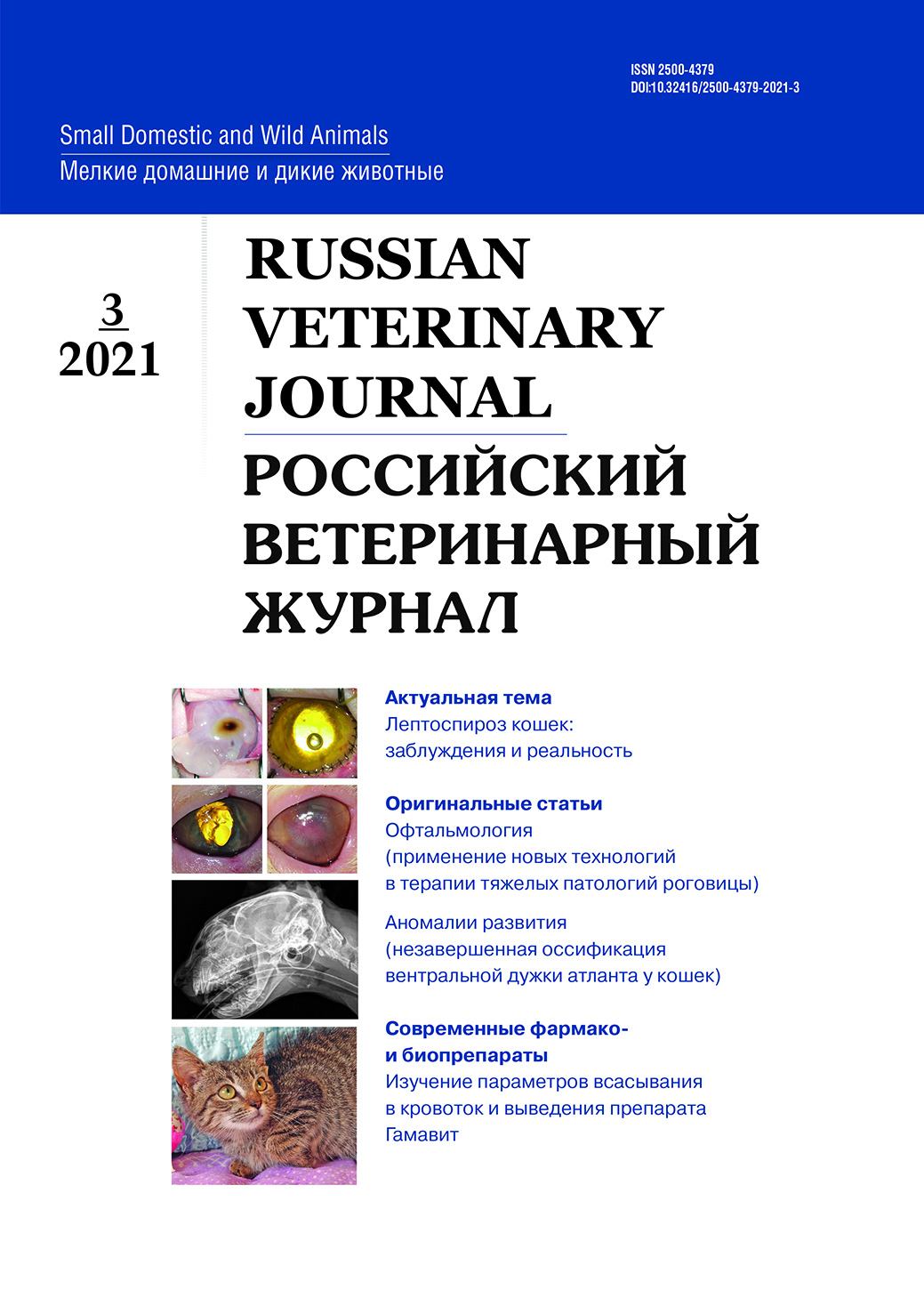Chain Veterinary Clinic «Swoi doctor» (head of the department of the roentgenology)
Veterinary Clinic «Aibolit» (doctor-roentgenologist)
Veterinary Hospital «Skolkovo Vet» (Veterinary radiologist)
Moskva; Krasnogorsk, Moscow, Russian Federation
Moscow State Academy of Veterinary Medicine and Biotechnology named after K.I. Skryabin
Veterinary Hospital «Skolkovo Vet» (Veterinary doctor of computer tomography)
Moskva, Moscow, Russian Federation
Chain Veterinary Clinic «Swoi doctor» (doctor-neurologist, roentgenologist)
Veterinary Hospital «Skolkovo Vet» (veterinary Doctor of magnetic resonance tomography)
Moskva, Moscow, Russian Federation
Moscow State Academy of Veterinary Medicine and Biotechnology named after K.I. Skryabin (doctor-neurologist)
Veterinary Hospital «Skolkovo Vet» (Veterinary neurologist)
Moskva, Moscow, Russian Federation
CSCSTI 68.41
Defects of the ventral arch of the atlas were detected on computed tomography in nine cats aged 3…12 months with signs of upper cervical injury including paina and ataxia. Seven cats have an ambulatory tetraparesis, and two cats have a nonambulatory tetraparesis. The bone defects were consistent with the normal location of the ventral arch growth areas of the atlas. In all observed cats, the pattern of ossification abnormalities was similar — the lateral portion of the arch was completely absent in seven cats on the left and in two cats on the right. The structure of the ventral tubercle was traceable in 8 of 9 cats. Also, in 8 of 9 cases an isolated bone fragment was observed lateral to the dens of the axis, the exact origin of which was not determined. This fragment was observed in 6 cases on the right, in two cases on the left, and only in two cases it corresponded to the side of the undeveloped arch. In 7 out of 9 cats, the dorsal arch was not fused; in 2 cats with complete fusion, the dorsal arch was deformed. An dens fracture was visualized in 3 cases, no hypoplasia of the dens was visualized, and one cat have atlantoaxial subluxation. Seven cats received conservative treatment and 2 cats received surgical treatment. Clinical improvement was observed in all cats. Disorder the ossification of the ventral arch of the atlas should be considered as the differential diagnosis in young cats with suspected atlanto-axial instability and trauma of the cervical spine. The authors were unable to find publications describing this atlas developmental abnormality in cats, so the authors believe that this is the first mention of incomplete ossification of the atlas in cats.
trauma, computed tomography, incomplete ossification, cat, vertebral column, atlas
1. Chambers A.A., Gaskill M.F., Midline anterior atlas clefts - CT findings, J Comput Assist Tomogr, 1992, No. 16, pp. 868-870.
2. Evans H.E., Miller’s anatomy of the dog, 4rd ed., Philadelphia, W.B. Saunders, 2013, 114 p.
3. Kinns J., Mai W., Seiler G., Zwingenberger A., Johnson V., Caceres A., et al. Radiographic sensitivity and negative predictive value for acute canine spinal trauma, Vet Radiol Ultrasound, 2006, No. 47, pp. 563-570
4. Klimo P., Blumenthal D.T., Couldwell W.T., Congenital partial aplasia of the posterior arch of the atlas causing myelopathy: case report and review of the literature, Spine, 2003, No. 28, pp. 224-228.
5. Klimo P., Rao G., Brockmeyer D., Congenital anomalies of the cervical spine, Neurosurg Clin North Am, 2007, No. 18, pp. 463-478.
6. Lappin M.R., Dow S., Traumatic Atlanto-Occipital Luxation in a Cat, Veterinary Surgery, 1983, Vol. 12, No. 1, pp. 30-32.
7. Mathews K., Non-steroidal antiinflammatory analgesics: Indications and contraindications for pain management in dogs and cats, Vet Clin NA: Small Anim Pract, 2000, Vol. 30, No. 4(July), pp. 783-804.
8. Owen M.C., Davis S.Y., Worth A.J., lmaging diagnosis - traumatic myelopathy in a dog with incomplete ossification of the dorsal lamina of the atlas, Veterinary Radiology and Ultrasound, 2008, No. 49, pp. 570-572.
9. Parry A.T., Upjohn M.M., Schlegl K., Kneissl.S., Lamb C.R., Computed tomography variations in morphology of the canine atlas in dogs with and without atlantoaxial subluxation, Vet Radiol Ultrasound, 2010, No. 51, pp. 596-600.
10. Senoglu M., Safavi-Abbasi S., Theodore N., Bambakidis N.C., Crawford N.R., Sonntag VKH. The frequency and clinical significance of congenital defects of the posterior and anterior arch of the atlas, J Neurosurg Spine, 2007, No. 7, pp. 399-402.
11. Shelton S.B., Bellah J., Chrisman C., McMullen D., Hypoplasia of the odontoid process and secondary atlantoaxial luxation in a Siamese cat, Prog Vet Neurol., 1991, No. 2, pp. 209-211
12. Warren-Smith C.M., Kneissl S., Benigni L., Kenny P.J., Lamb C.R., Incomplete ossification of the atlas in dogs with cervical signs, Vet Radiol Ultrasound, 2009, No. 50, pp. 635-638.
13. Watson A.G., De Lahunta A., Evans H.E., Morphology and embryological interpretation of a congenital occipito-atlanto-axial malformation in a dog, Teratology, 1988, No. 38, pp. 451-459.
14. Wrzosek M., Plonek M., Zeirat O., Biezynski J., Kinda W., Guzinskiý M., Congenital bipartite atlas with hypodactyly in a dog: clinical, radiographic and CT findings, Journal of Small Animal Practice, 2014, No. 55, pp. 375-378.
15. Kemelman E.L., Yagnikov S.A., Kuleshova O.A., Two cases of atlas ossification violations with the splitting of the temples in dogs, identified by computed tomography, Russian veterinary journal Small domestic and wild animals. , 2013, No. 3, pp. 38-40 (In russ.)








